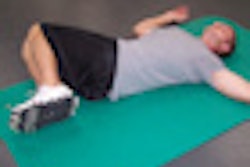Small hospitals without onsite access to high-end imaging modalities such as CT or MRI rely heavily on the diagnostic capabilities of ultrasound, and this dependency for imaging of emergent patients and acute care inpatients has been exacerbated by ever-increasing outpatient volumes.
In addition, financial pressures to maintain or increase potential revenue have added to the pressure to deliver increasing ultrasound case loads, which have resulted in demanding service requirements, team member shortages, and a high vulnerability to work-related injuries.
Work-related musculoskeletal injuries in the field of sonography have been well documented for many years, and recent studies have documented astonishing findings. Some studies have indicated high percentages of sonographers having experienced some degree of pain related to performance of their duties. Studies also suggest that these injuries can affect sonographers for prolonged periods of time and can affect aspects of everyday life -- in addition to resulting in a significant number of sonographers having to end their scanning careers.
The Society of Diagnostic Medical Sonography (SDMS) performed a study in 2000, and the results were astounding. Of the 10,000 sonographers participating in the study, 84% had experienced some degree of pain related to performance of their duties. Of this group, 90% experienced this pain for more than half of their scanning careers. The most shocking statistic is that 20% had experienced an injury severe enough to end their scanning careers.
The most commonly reported scanning-related injuries include those in the lower back, cervical spine, hands, wrists, and shoulders. The most common mechanisms of injury include prolonged standing, awkward standing postures, static and dynamic awkward arm positions, reaching injuries, and pinching-type grips. The root cause of the injuries can be traced to the cumulative effect of repetitive movements, combined with prolonged awkward arm positions and static gripping of transducers, as well as force exerted through the scanning process.
Technologist-friendly products
In an attempt to mitigate these injuries, medical equipment companies have invested a great amount of research into more technologist-friendly products and applications. A large emphasis has also been placed on ergonomic tables, positioning aids, fatigue minimizing floor mats, and probe handling devices.
At our institution, the Tillsonburg District Memorial Hospital (TDMH) in Ontario, Canada, ultrasound team members complete approximately 12,000 exams on 7,500 patients per year. Ultrasound services utilize three Philips Healthcare (Andover, MA) ATL units; two of the units are older ATL 5000 systems and one unit is a state-of-the-art iU22 scanner.
As well as utilizing adequate quality imaging systems, TDMH has taken many steps to try to limit these scanning-related risks, such as purchasing technologist-friendly scanning chairs, ergonomic scanning tables that meet patient and technologist requirements, and scanning equipment that incorporates many new ergonomic features. Ergonomic kits containing information, exercise charts, and strengthening equipment have also been purchased for each sonographer.
These steps all provided incremental improvements to the working environment, but demands on the service still seemed to outweigh their intended improvement. Team members were still at risk and showing signs of muscle fatigue, joint fatigue, and pain.
The summer of 2008 triggered a lost-work-time injury to one of the three full-time sonographers. There have been other work-related injuries in the past, as well as intermittent general discomfort experienced by many team members.
A new plan
Focusing on hospital policies reflecting the culture of safety, occupational health and safety programs, and the Occupational Health and Safety Act, a process investigation and improvement plan was started.
Process improvement goals included the following:
- Improve ultrasound team members' processes to help mitigate risk for musculoskeletal injuries.
- Define and document potential sources of injury due to patient scanning.
- Improve communication and interactions between ultrasound team members and scheduling department.
- Improve communications and interactions between the physicians ordering ultrasound testing.
- Educate team members to improve the level of awareness regarding scanning-related injuries.
- Educate team members to recognize the early signs and symptoms of scanning-related injuries.
- Provide team members with the equipment and time to stretch and strengthen to help avoid scanning-related injuries.
- Define and document improved processes, policies, and procedures.
The steps below were part of the process analysis:
- Review literature regarding musculoskeletal injury and risk to sonographers.
- Review technologist workloads.
- Benchmark with other departments regarding technologist workloads.
- Review scheduling patterns.
- Change scheduled cases to minimize high-impact cases being scheduled back to back.
- Occupational Health and Safety Team member review of scanning processes and techniques.
- Rehabilitation Services review of ultrasound-related injuries.
- Rehabilitation Services review of proper body mechanics with the sonographers related to their scanning duties.
- Rehabilitation Services led preventative stretching and strengthening program for each technologist.
The resulting investigation led us to many conclusions and steps to help improve the conditions.
Emergent workloads
The ultrasound team faces steady outpatient scheduling patterns. This differs from other services that have an ebb and flow to case loads; ultrasound cases are booked consistently throughout the day. To meet the challenges of emergency services, a review of the number of emergent cases on a daily basis lead us to implement a more appropriate number of open emergency slots on a day-to-day basis. This enabled the team members to complete scheduled outpatients and emergent cases as required, and ensured that team members had adequate time between exams and for breaks.
Scheduling of exams
As a result of the investigation, the scheduling of ultrasound patients has been modified to provide a better mix of cases with varying levels of postural stress. For example, more intense examinations were not scheduled back-to-back. The duration of the exams has also been reviewed to ensure appropriate time frames are being applied to the different types of cases performed.
Review of physical elements
Employee health and wellness team members reviewed the actual scanning of several patients and were interested in the body position of the technologists while they were performing the scans. We reviewed the ergonomic aids available to the technologists, both intrinsic to the ultrasound device, monitor position, command features, and functions and extrinsic, such as sponges, supports, scanning tables, and technologist chairs. We reviewed many product catalogs and feel that all available ergonomic aids have been utilized within the scanning rooms.
Exercise and strengthening
Karen Atkins, service coordinator for TDMH's Rehabilitation Services department, reviewed much of the literature available online regarding sonography-related ergonomic risks and common injuries, as well as prior methods made available to the technologists to help with strengthening and prevention of injuries. She designed a dedicated set of stretching and strengthening exercises to provide the team members with a means of mitigating some of the injury risk. A 45-minute window per week, as well as a location with strengthening and stretching equipment, has been provided to the technologists for this preventative program.
The stretching and strengthening program includes stretching and range-of-motion exercises for the cervical spine, in addition to stretching and strengthening exercises for the shoulder, particularly the rotator cuff muscles, and the forearm, wrist, and hand.
As of May 2009, the stretching and strengthening program and the scheduling and ergonomic-based changes had been in place for seven months. With the understanding that many of the steps taken to mitigate the injuries are preventative in nature, the measurements of outcomes can be greatly subjective. Our initial review of the process after the first six months leads us to believe that the technologists are feeling some improvement to the generalized aches and pains they're experiencing.
By Rob VanDoninck and Karen Atkins
AuntMinnie.com contributing writers
July 14, 2009
Rob VanDoninck is shared director of diagnostic imaging and laboratory services at Alexandra Hospital in Ingersoll and Tillsonburg District Memorial Hospital in Tillsonburg. Karen Atkins is service coordinator of rehabilitation services at Tillsonburg District Memorial Hospital.
Related Reading
Lean principles and ergonomics aid imaging management, April 30, 2008
U.S. government issues update on WRMSDs in sonography, December 25, 2006
Tackling ergonomic issues in sonography, September 13, 2004
Managing ultrasound ergonomics, March 26, 2004
A multimedia guide to ergonomic sonographer positioning, September 18, 2002
Copyright © 2009 AuntMinnie.com



















